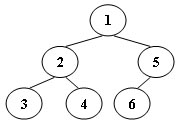An inorder binary tree traversal can be implemented in a non-recursive way with a stack. For example, suppose that when a 6-node binary tree (with the keys numbered from 1 to 6) is traversed, the stack operations are: push(1); push(2); push(3); pop(); pop(); push(4); pop(); pop(); push(5); push(6); pop(); pop(). Then a unique binary tree (shown in Figure 1) can be generated from this sequence of operations. Your task is to give the postorder traversal sequence of this tree.

Figure 1
Input Specification:
Each input file contains one test case. For each case, the first line contains a positive integer N (≤30) which is the total number of nodes in a tree (and hence the nodes are numbered from 1 to N). Then 2N lines follow, each describes a stack operation in the format: "Push X" where X is the index of the node being pushed onto the stack; or "Pop" meaning to pop one node from the stack.
Output Specification:
For each test case, print the postorder traversal sequence of the corresponding tree in one line. A solution is guaranteed to exist. All the numbers must be separated by exactly one space, and there must be no extra space at the end of the line.
Sample Input:
6
Push 1
Push 2
Push 3
Pop
Pop
Push 4
Pop
Pop
Push 5
Push 6
Pop
Pop
Sample Output:
3 4 2 6 5 1
个人分析:??怎么又要遍历树了,emmmmmm。题目给出了目标树中序堆栈遍历的出入栈顺序,要求据此得出目标树的后序遍历顺序并输出,输出老套路,前面各个数都要用空格隔开,最后不能有空格。菜鸡第一想法:根据输入建树,然后写一个后序遍历输出即可。
又是一句这么简单的分析.....现在看越清晰的题目越害怕,弯弯绕不一定就少。
“根据输入建树”这就是第一个弯了,一般来说,可以根据树的前中后序遍历中的二者,求出第三者。然后,题目好像只告诉我们了中序遍历顺序,还信誓旦旦的告诉我们,一定能得出唯一的后序遍历顺序......真是woc啊.....当然,不可能是题目错了,只能是菜鸡还没发现诀窍。
再仔细想想,题目好像确实给了俩个数字序列:push序列+pop序列。有 、意思!emmmm,用样例看看是不是能从这俩个序列里唯一确定一棵树,如图:
原来真的可以唯一确定一棵树,想想也应该,因为输入确实“唯一的”遍历了树,不可能有两棵不同的树有同种中序遍历顺序。
问题到这里,本来已经可以写出满足测试的代码了。但是,陈越姥姥曾给我们一个思路:是不是一定要建树?
是否仅仅根据这两行序列,就能直接得到后序遍历的输出?emmmmmm其实确实可以,但是菜鸡当时没那么聪明,还是建树了,再者还想练一下建树的代码。

代码如下:
#include<stdio.h>
#include<stdlib.h>
#define Maxsize 30
int tag=0; //改变输出格式
//链式堆栈结构体声明
typedef struct StackNode* Link;
struct StackNode{
int data;
Link next;
};
//链式树结构体声明
typedef struct TreeNode* BinTree;
struct TreeNode{
int data;
BinTree left;
BinTree right;
};
//创建树头结点
BinTree CreateTree(int X)
{
BinTree T=(BinTree)malloc(sizeof(TreeNode));
T->data=X;
T->left=NULL;
T->right=NULL;
return T;
}
//建树函数
BinTree BuildTree(int s1[],int s2[],int head,int end,int size,BinTree T,int position)
//head与end标注当前结点左右儿子在出栈序列中的取值范围
{ int limit;
//limit当前结点在出栈序列中的位置,position当前结点在入栈序列中的位置
for(int i=0;i<size;i++)
{
if(T->data==s2[i])
{
limit=i;
break;
}
}
if(limit>head+1) //表明当前结点有左儿子
{
BinTree tl=(BinTree)malloc(sizeof(TreeNode));
tl->data=s1[position+1];
tl->left=NULL;
tl->right=NULL;
T->left=tl;
BuildTree(s1,s2,head,limit,size,tl,position+1);
}
if(limit<end-1) //表明当前结点有右儿子
{
BinTree tr=(BinTree)malloc(sizeof(TreeNode));
tr->data=s1[position+(limit-head)];
tr->left=NULL;
tr->right=NULL;
T->right=tr;
BuildTree(s1,s2,limit,end,size,tr,position+limit-head);
}
return T;
}
//堆栈初始化头结点函数
Link CreateStack()
{
Link P=(Link)malloc(sizeof(StackNode));
P->next=NULL;
return P;
}
//堆栈判空函数
bool IsEmpty(Link T)
{
if(T->next==NULL)
return false;
else
return true;
}
//堆栈入栈函数
Link Push(Link T, int X)
{
Link rear=(Link)malloc(sizeof(StackNode));
rear->data=X;
rear->next=T->next;
T->next=rear;
return T;
}
//堆栈出栈函数
int Pop(Link T)
{
if(IsEmpty)
{
Link Topitem;
int Data;
Topitem=T->next;
T->next=Topitem->next;
Data=Topitem->data;
free(Topitem);
return Data;
}
else
{
printf("栈空\n");
return 0;
}
}
//树后序遍历函数
void PostOrderTravel(BinTree q)
{
if(q){
PostOrderTravel(q->left);
PostOrderTravel(q->right);
if(tag==0)
{
printf("%d",q->data);
tag=1;
}
else
{
printf(" %d",q->data);
}
}
}
int main()
{
//建立堆栈,根据输入,得到入出栈序列
int size,number,rear1,rear2;
rear1=rear2=0;
Link Top;
char a[4];
int s1[Maxsize];//记录入栈序列
int s2[Maxsize];//记录出栈序列
Top=CreateStack();
scanf("%d",&size);
getchar();
for(int i=0;i<2*size;i++)
{
scanf("%s",&a);
if(a[1]=='u')
{
scanf("%d",&number);
getchar();
Push(Top,number);
s1[rear1]=number;
rear1+=1;
}
else if(a[1]=='o')
{
getchar();
s2[rear2]=Pop(Top);
rear2+=1;
}
}
//根据入出栈序列构造树
BinTree T=CreateTree(s1[0]);
BinTree Q=BuildTree(s1,s2,-1,size,size,T,0);
//树的后序遍历
int tag=0;
PostOrderTravel(Q);
}
测试结果:
总结:苏服啊苏服,还是要去学习一下怎么直接得出后序输出,感觉数学学的更好一点,写的代码能更美更简洁!

